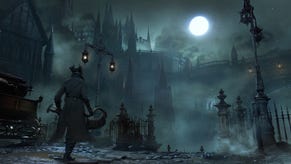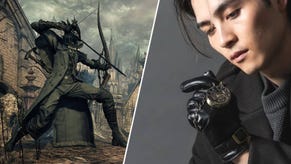Cthulhu voodoo: why Bloodborne is the best Lovecraftian game
Sherif Saed tackles Bloodborne's links to Lovecraftian horror, explaining why you should face the madness and immerse yourself in its lore. Spoilers inside.
No other game could commit to its themes so religiously without feeling the need to compromise its vision and veer towards accessibility. Bloodborne stands tall above any game that dares attach itself to the framework of Lovecraftian horror.
Having finished Bloodborne a few days ago, I can safely say it’s my game of the year so far. But you already know it’s a great a game. You can see its majesty. And I would go so far as to say it’s worth buying a PlayStation 4 for. Be warned: story spoilers are included in the article below.
Blodborne’s strengths aren't only owed to its satisfying combat or the core of its gameplay loop. Those are present here just like they were in other Souls games. They’re refined in some ways, sure, but they never stray far from the Souls foundation. The real marvel of Bloodborne is how it perfectly marries its thematic inspirations to its gameplay mechanics.
Bloodborne starts off as a Van Helsing-Victorian Era-monster-hunting game. Towards the second half, it opens to show the real story and inspirations rooted in Lovecraftian horror themes, specifically Cosmic Horror.
As you go through Yharnam and Bloodborne's other regions, you’ll see statues, read notes and item descriptions that allude to the existence of beings with higher powers occupying the city’s plane. The topic of alien miscegenation, specifically the higher beings’ quest to procreate by using a human surrogate, becomes more important as you progress. This notion is at the centre of the game's religion. It has given birth to a multitude of sects, each furthering their own agenda while attempting to make contact with said beings and receive the honour of delivering the new reborn.
It took me a while to wrap my head around. Reading the words “The Great Ones” reminded me of The Great Old Ones. The game’s tentacle-sporting monsters, its dreamscape realm, the recurring theme of birth and ascension, the obsession with eyes and the need to see more, are all staples of Lovecraftian literature. Not only that, but they’re all told through the same hazy, imperfect, and sometimes unreliable narration. It's the same narration trick every Souls game, as well was plenty of Lovecraft's work, utilised before it.
Bloodborne didn't need to switch from one storytelling method to another, and it didn't need to betray its roots and expose everything in cut-scenes. Because both storytelling patterns are, largely, one and the same.
Insight to madness
The masterful design doesn't stop there. Any other game would've been content with slapping Cthulhu-like imagery on its walls, or having a meaningless story involving higher powers, without trying to somehow work them into its mechanics. A good example of this would be Call of Cthulhu: Dark Corners of the Earth. It started off fine, but then you got a gun and started shooting everything. You acquired power, you had a role, and you stopped being helpless and disconcerted. It turned into a mundane shooter.
Bloodborne, however, is a Souls game. It’s the only modern game that could get away with truly adopting a Lovecraftian theme in both its story and gameplay. It can add any number of obtuse, f**k-you mechanics and we'd never bat an eye.
Take ‘Insight,’ for example. It's a major gameplay feature in Bloodborne, and also functions as a narrative device. I'll explain how both work in tandem. Insight is gained by killing bosses, or in some instances by just being in the arena with them for a few seconds. It’s also gained by consuming items called Madman's Knowledge, which the game describes as the skulls of a madman touched by the wisdom of the Great Ones. When Insight reaches certain thresholds, you’ll start seeing things you didn't before, some of which you've fruitlessly interacted with on numerous previous occasions and, confused, wrote off to “Souls games”.
As you open up new areas, you'll encounter and kill more bosses and raise your Insight level. Provided you don’t lower your Insight, enemies will start getting new attacks, and your resistance to Frenzy will be lowered with every new Insight you gain. So, what is Insight? Is it a grief mechanic? No. Far from it, in fact. Notice how it's named ‘Frenzy,' and how your resistance to it is lowered the more Insight you have? ‘Insight’ and ‘Frenzy’ aren't just grandiose names for game features, but rather the essence of this entire game.
This ramp works both inside and outside of the game. As you familiarise yourself with Bloodborne and your Insight rises, your eyes begin to open and you become less naive. And just like that, the game elevates you from an animal (beast) looking to hunt, to a being starving for knowledge both in fantasy and reality. And thus begins your quest, the same journey suffered by many NPCs, the price of which is madness (hence the name 'Frenzy'). These themes are essential to Lovecraftian horror.
The horrors you encounter all induce Frenzy. The Madman’s Knowledge skulls are found where rituals were conducted to communicate with the higher beings, in places known for studying. They’re the skulls of scholars and students fatally smothered with knowledge. They went mad.
Reaping, sowing
Bloodborne starts wrapping back around the hunt at this point. You’re at a crossroads. The decision is whether or not to continue the hunt, become more in tune with your beastly side, go back to the dream and dismiss all that you've seen as illusions (raising your Beasthood and Frenzy Resistance stats as result), or dive deeper into the plot, ascending, granting the Great Ones' desires by becoming a powerful being to bear their child (thus increasing your Insight and lowering Frenzy Resistance).
No other game could commit to its themes so religiously without feeling the need to compromise its vision and veer towards accessibility. Bloodborne stands tall above any game that dares attach itself to the framework of Lovecraftian horror.
It almost ends up being an allegory of itself. Immerse yourself in the lore you’ll end up discovering something far more elaborate. Until you go mad with knowledge, obviously.
More will be revealed in Bloodborne as people start finishing their second and third play-throughs, but one thing will remain true: there’ll never be a true interpretation of the story. Something I felt reading my first H.P. Lovecraft book.










